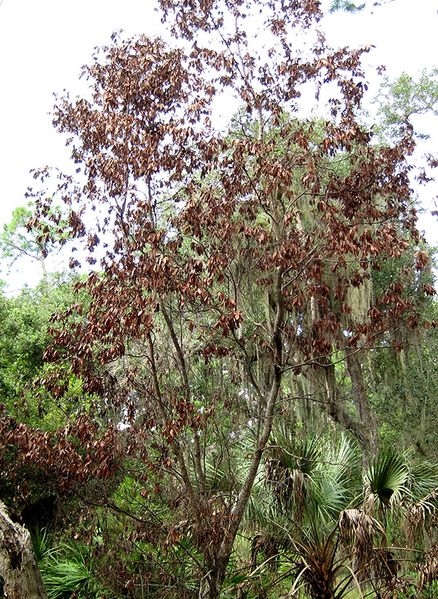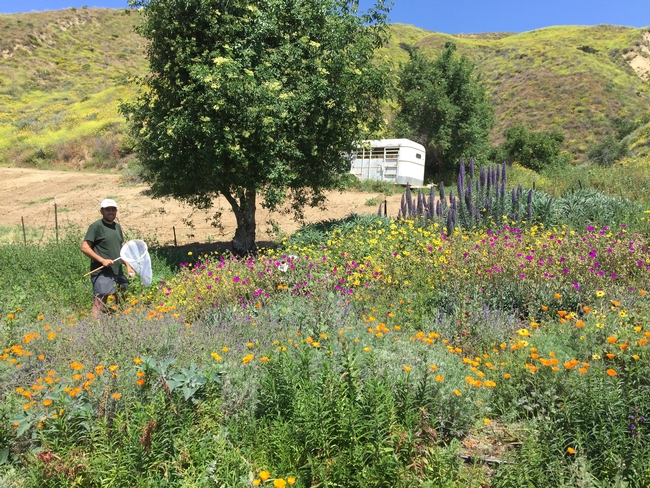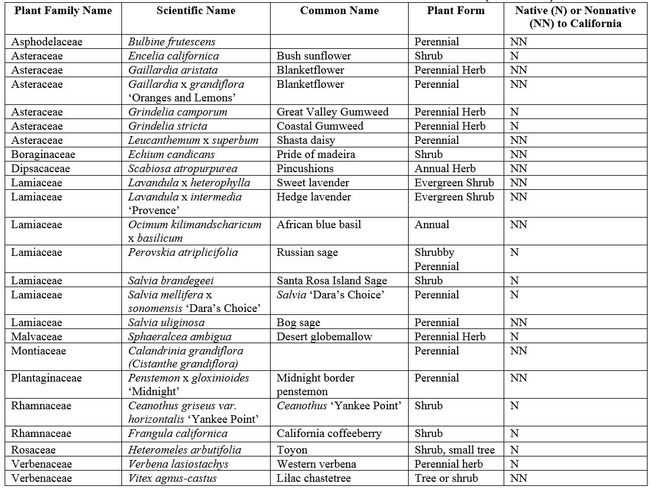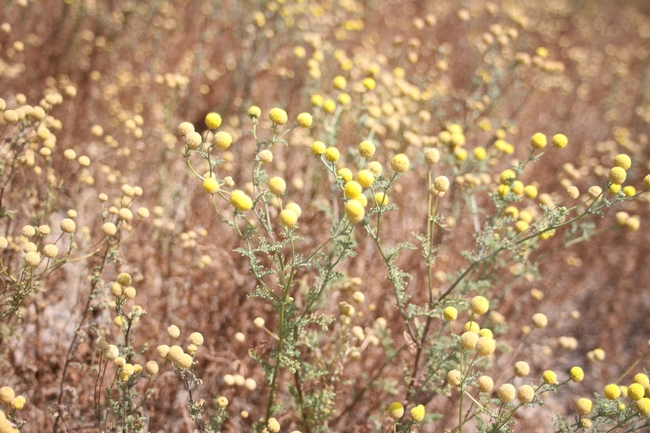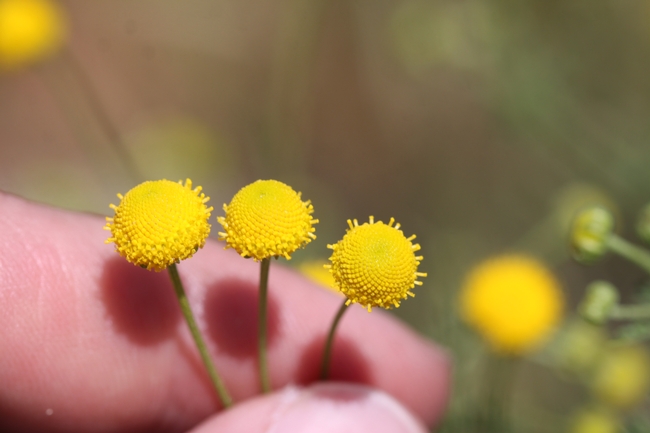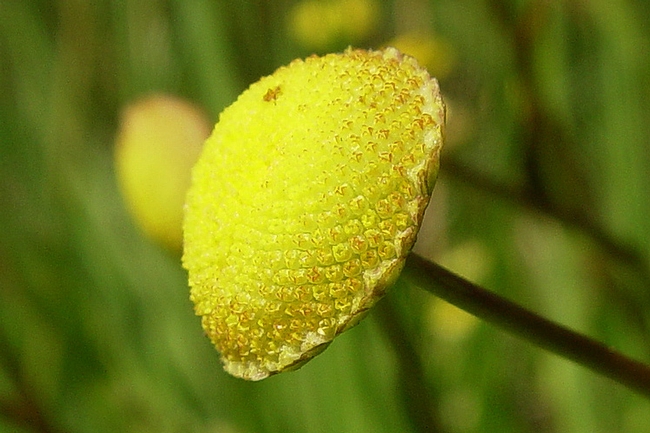- Author: Ben Faber
Evaluating claims of new products that could potentially improve yield and tree health is a daunting task. Every week I get calls and literature from people promoting fertilizers and techniques that "resist insects," "reduce salt levels in the soil," "increase crop quality," "release that natural fertility of your soil," and numerous other claims. There just is not enough time in the day to approach each and every one of these materials or techniques, even though some may, in fact, be promising.
So what does a grower do? You hear about a new product. It only costs $20 an acre to apply. Might as well fly it on all 50 acres. But then, how do you know it has done anything? What results do you have to compare it with? Last year's yield which was miserable? We know how variable avocado yields are, so last year's harvest may not be a good comparison.
When we conduct field trials, we assume a clear comparison is available to test the effects of the treatment. With field trials, there are usually small plots, repeated several times (at least three), and arranged in an apparent haphazard (random) fashion. The reason is threefold: 1) to account for variability in the field, 2) to prevent a systematic bias in favor of one treatment over another and 3) to see if differences in treatments are due to chance or to the superiority of the treatment.
How are observational trials different from replicated one? The big difference is that they are not replicated. Each treatment occurs only once, so we have no measure of the natural variability in the field or trees. As a result, we risk thinking we have a difference due to treatment which is actually due to field variability. Without replication there is no way to tell.
Let's examine this replication idea a little more closely. We had a frost trial where we applied copper or a water control spray to young trees in November. Copper is a noted bactericide and the idea was to control the frost-nucleating bacteria. Forty trees, randomly spaced in the orchard were sprayed with either a dilute copper spray according to instructions or water alone. We evaluated frost damage to the trees in January. The first counts showed 40% frost damage with the copper spray and 60% with the water alone. Great. Let's go out and spray the whole orchard next year with copper. However, successive counts showed 50% frost damage with the copper and only 30% from the water. In the end, there was no significant difference to trees that had been sprayed with either material.
These results show the natural variability in biological systems and demonstrate the disadvantages in looking at results from a non-replicated trial based on a single year. This becomes even more important when interpreting information from a trial site different from your own. If every grower sprayed a non-replicated treatment at their own ranch, the risk of coming to the wrong conclusion about that treatment at each location is still 50%. Just like flipping a coin. Is that worth spending money on?
As each of the variables (soil type, irrigation quality, management, etc.) increases, the risk of making a poor decision about a product or practice increases, as well. You can see that there are difficulties associated with relating information from a non-replicated trial based on a single year of data at a different location to your own situation.
How does someone go about evaluating a new practice or material at home without going through all the complications of a complicated research trial? Mary Bianchi, retired Farm Advisor in San Luis Obispo and I came up with a little checklist.
- Be conservative in your approach and critical observations. Resist the urge to spray the whole grove. Leave something, so that a comparison can be made. Preferably run a side-by-side comparison.
- Use consistent farming practices across all areas of the trial.
- Compare the new practice to one which is a standard for your operation.
- Don't bias your results by implementing the new practice where it stands to have the best effect anyway. For example, don't spray boron on the trees that always give a good yield.
- Run the test more than one year and in more than one location, especially if the new practice is costly.
- Talk to the industry and use the experience of others in different locations as a check on your own experience. A good place to swap ideas is at the California Avocado Society/CA Avocado Commission/University of California Cooperative Extension sponsored bimonthly meetings.
Research does not need to be complicated, but it needs to be thought out before hand with consistent data collection and given time. And time is critical, especially for nutrient studies and with a tree like avocado, that has a prolonged bloom with alternate bearing and usually more than one crop at a time. The effects of application timing at a given rate might not be determined for several years of crop yield. Persistence is the key to experimentation. Unless it's a pesticide trial, do you see results in the first year.
It's not really like this!!
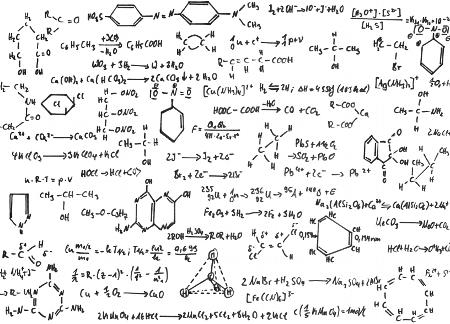
- Author: Alli Fish
The Buzz about Hedgerows
Hedgerows are an approved practice under California Department of Agriculture's Healthy Soils Grant Program. That means, growers are eligible to receive grant funding for planting hedgerows. But what exactly are the benefits of hedgerows and why are they worth planting? As a perennial planting it can have immediate impacts on the soil, but what else? The answer lies large in the pollinators and beneficial insects they attract.
The most basic definition of a hedgerow is dense vegetation planted in a linear design. Perennial grasses, shrubs, and even short trees are all candidates for hedgerow plantings, provided they meet the conditions of the local climate and soil. Growers plant hedgerows to achieve one or more of the following desired outcomes:
- To increase habitat for pollinator and beneficial insect populations
- To create a living barrier or fence
- To reduce chemical drift or odor movement
- To intercept airborne particulate matter
- To act as a low windbreak or reduce dust
- To increase carbon storage in biomass and soils
- To provide food, shelter, and shade for aquatic organisms in nearby aquatic habitats
All of these benefits make the case for planting hedgerows on any agricultural operation. In Ventura County, avocado growers stand to see a compelling case for hedgerow plantings with particular attention to pollination services.
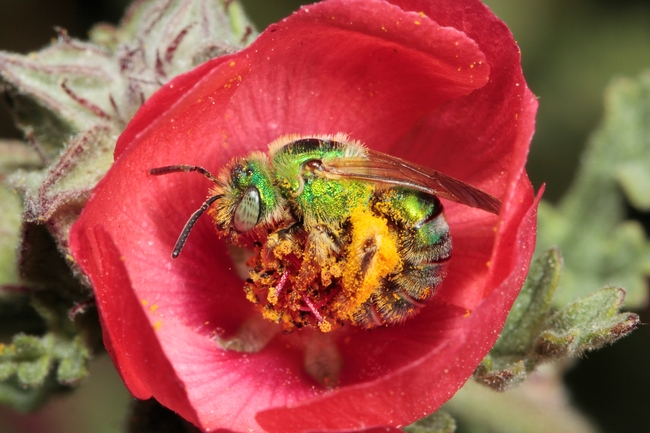
There are many different pollinators who visit avocado flowers, from native bees to flies to honey bees. Some come in the daytime, others visit at night. In the likelihood that honey bees and other pollinators will continue to decline, it is imperative to study the importance of native pollinators on key crops and identify ways to increase habitat for resident populations (NRC 2007; Nordhaus 2011; PHTF 2015; Koh et al. 2016; Sánchez-Bayo and Wyckhuys 2019; DiBartolomeis et al. 2019; Garibaldi et al. 2013). This information not only helps the pollinator populations thrive, but helps avocado growers acquire free increased pollination services for fruitful trees. Several researchers have published accounts of increased pollinator diversity and numbers in hedgerow and field edge planting studies across various agricultural systems (Heller et al. 2019; Long and Anderson 2010; Long et al. 2017; Williams et al. 2015).
In Ventura County, we are seeing some fascinating and relevant research around the impact of hedgerows on pollinators in avocado orchards. A collaborative research project involving Dr. Ben Faber, Avocado Advisor for UC Cooperative Extension Ventura County, and Dr. Gordon Frankie, professor and research entomologist at UC Berkeley and lead investigator of the UC Berkeley Urban Bee Lab, seeks to understand long-term impacts of hedgerows on pollinators of avocado trees. The project, which began in 2014 with three participating avocado ranches, has indicated increased pollinator activity, increased native bee populations, and increased diversity of species with the presence of hedgerow plantings (Frankie, Faber et al. 2020). The results indicate the importance of diversity of pollinator species, not just the honeybee, to avocados. In continuing this research, the team seeks to address the unanswered questions of which pollinators are the most effective at pollinating avocados and which are the most effective at influencing fruit set. A particularly exciting and novel aspect of this project is looking at whether or not there are nocturnal pollinators visiting California avocados. Nocturnal pollinators have been well documented in New Zealand (Pattemore et al, 2018), but none have been yet recorded in California avocados.
Maintaining hedgerows is critical to providing additional habitat for an abundance of pollinators. Creating and maintaining that hedgerow and for which pollinators can be a daunting task to embark on. Luckily for avocado growers, Dr. Frankie and Dr. Faber's team are working with Southern California growers to develop a pollinator garden manual. The manual will provide clear pictures of key pollinators and key plant species that pollinators are drawn to. Detailed imagery, descriptions, and maintenance tips will help make the decision making around planting a hedgerow much easier.
Speaking of selections, there are key plants that are drought-tolerant, easy to maintain, and well-suited for Ventura County's climate. See the table below for some ideas.
Table 1. Main Native Bee Plants Installed in Avocado Orchards 2014-2019
We seek to increase biodiversity, build soil health, and reduce energy use in our agricultural systems to improve our resiliency to climate change impacts, pests, and disease. To keep farming in our families and in our futures. Planting hedgerows is good for the pollinators, which is good for the bottom line and long-term success of the operation.
If you are an avocado grower interested in learning more about the pollinator research project, please contact Dr. Gordon Frankie at the UC Berkeley Urban Bee Lab gwfrankie@berkeley.edu.
Interested in planting hedgerows on your property? You may be able to qualify for a grant through CDFA's Healthy Soils Grant Program to plant hedgerows. Please contact Jamie Whiteford with the Ventura County Resource Conservation District at jamiewhiteford.vcrcd@gmail.comfor more information on how to apply. For those in other areas, Technical Assistance providers are able to discuss the values of hedgerows and funding opportunities for installing them in other agricultural situations: http://ciwr.ucanr.edu/Programs/ClimateSmartAg/TechnicalAssistanceProviders/
Bombus vosnesenskii photo by Rollin Coville
References Cited
DiBartolomeis, M., S. Kegley, P. Mineau, R. Radford, and K. Klein. 2019. An assessment of acute insecticide toxicity loading (AITL) of chemical pesticides used on agricultural land in the United States. PLoS ONE 14(8): e0220029. https://doi.org/10.1371/journal.pone.0220029.
Frankie, G., B. Faber, J. Pawelek, R. Thorp, R. Coville, C. Jadallah, E. Takele, S. I. Rios, T. Bean. 2020. Native Pollinators of California Avocado as Affected by Introduced Pollinator Gardens. International Society of Horticultural Sciences Congress. Acta Horticulturae.
Garibaldi, L.A., I. Steffan-Dewenter, R. Winfree, and 47 other authors. 2013. Wild pollinators enhance fruit set of crops regardless of honey bee abundance. Science 339:1608-1611.
Heller, S., N. K. Joshi, T. Leslie, E. G. Rajotte and D. J. Biddinger. 2019. Diversified Floral Resource Plantings Support Bee Communities after Apple Bloom in Commercial Orchards. Scientific Reports 9 Article number: 17232.
Koh, I., Lonsdorf, E. V., Williams, N. M., Brittain, C., Isaacs, R., Gibbs, J., Ricketts, T. H. 2016. Modeling the status, trends, and impacts of wild bee abundance in the United States. Proceedings of the National Academy of Sciences 113:140–145.
Long, R. F. and J. Anderson. 2010. Establishing Hedgerows on Farms in California. UC ANR Pub 8390, Oakland, CA. http://anrcatalog.ucanr.edu/Details.aspx?itemNo=8390
Long, R., K. Garbach and L. Morandin. 2017. Hedgerow benefits align with food production and sustainability goals. California Agriculture 71:117-119. 10.3733/ca.2017a0020.
NRC. 2007. Status of Pollinators in North America. National Research Council of the National Academies. National Academies Press, Washington, D.C.. 307 p.
Nordhaus, H. 2011. The Beekeeper's Lament. Harper Perennial, NY. 269p.
Pattemore, D., M. N. Buxton, B. T. Cutting, H. McBrydie, M. Goodwin, A. Dag. 2018. Low overnight temperatures associated with a delay in ‘Hass' avocado (Persea americana) female flower opening leading to nocturnal flowering. Journal of Pollination Ecology 23(14): 127-135.
PHTF: Pollinator Health Task Force. 2015. Pollinator Research Action Plan. The White House.
Sánchez-Bayo, F. and K. A. G. Wyckhuys. 2019. Worldwide decline of the entomofauna: A review of its drivers. Biological Conservation 232:8-27.
Williams, N. M., K. L. Ward, N. Pope, R. Isaacs, J. Wilson, E. A. May, J. Ellis, J. Daniels, A. Pence, K. Ullmann, and J. Peters. 2015. Native wildflower plantings support wild bee abundance and diversity in agricultural landscapes across the United States. Ecological Applications 25: 2119–2131
- Author: Chris McDonald
reposted from: https://ucanr.edu/blogs/blogcore/postdetail.cfm?postnum=41400
Stinknet (Oncosiphon piluliferum, aka globe chamomile) is a winter annual that is spreading across Southern California and poses threats to wildlands, rangelands and agricultural areas. Stinknet was first found in western Riverside County in the early 1980's. It slowly spread to surrounding areas and by the late 1990's it was found in over a half dozen locations in Riverside and San Diego Counties. By this time, it had also spread to Phoenix. While stinknet has not been one of the fastest weeds to spread across the state (stinkwort, Dittrichia graveolens, is definitely a top contender for that spot, see here) it is now currently found in every county in Southern California (except Imperial, yet) with the largest infestations in Riverside and San Diego Counties. Stinknet continues to spread north across Los Angeles, the central valley and coast, and east across Arizona, it was also recently found in Las Vegas.
Identification
Stinknet is easiest to identify when in flower. At flowering, it grows from several inches to 3 feet tall.
Stinknet in full flower (Image credit: Chris McDonald)
A closeup of stinknet flowers (Image Credit: Chris McDonald)
Stinknet is closely related to the pineapple weeds (Matricaria spp., see here) and brass buttons (Cotula spp. see here and here), and resembles those more common weeds. The main difference is the flower of stinknet is very round, like a globe, (see above) while the flowers of pineapple weed and brass buttons tend to be slightly conical to half a sphere.
Brass buttons (Cotula coronopifilia Image credit: Carol Witham)
Pineapple weed and brass buttons also tend to grow more along the ground, and stinknet grows upright. Another diagnostic feature is that stinknet stinks. All plant parts have an unpleasant turpentine, pine or tar-like smell, and even very small plants have this smell. You can even smell the odor of a large field of stinknet when you are near a very large infestation.
Successful Control Options
Stinknet can be controlled with several herbicides that can be used in wildlands. Milestone (aminopyralid), Capstone (aminopyralid and triclopyr) and glyphosate are all highly effective at controlling stinknet, but only before the plants have flowered. Often if herbicides are applied after flowering, stinknet can finish flowering before the herbicides have killed the plant. Milestone and Capstone also provide season-long control of stinknet with suppression lasting up to and in some cases beyond 12 months. Several researchers, including myself, are working on other control measures and understanding its biology to better help managers control stinknet. Those projects should wrap up in the next year or two.
What doesn't work well at controlling stinknet?
Telar XP (chlorsulfuron) was not effective at controlling stinknet in Southern California. Transline (clopyralid) was inconsistent at controlling stinknet. Transline had shown promise of effective control in relatively dry years, but in other more wet years the treated plants were able to grow out of the treatment. Mechanical removal (mowing or string trimmers) has shown to be of limited effectiveness, mostly because the cut plants resprout and flower closer to the ground. Multiple cuttings close to the ground alleviate this problem and can provide good control, but a simple single cutting is not very effective. Stinkent can grow in dense patches so hand pulling will only work on a very small scale, and multiple sessions are needed. Stinknet is not palatable to livestock, so grazing will not be an effective management strategy and can make the problem worse.
Threats to California Agriculture
In Western Australia, stinknet is a problem weed in small grain crops. In both South Africa (the home range of stinknet) and Austrailia stinknet is a problem weed in rangelands too. This is because stinknet is unpalatable to many livestock. While stinknet is not currently known to be toxic, there are reports it can taint the meat and milk from those animals. If the patterns in Australia and South Africa hold in the US (and so far in a few observed cases it appears to be similar) and if stinknet continues to spread into rangelands and agricultural areas in California, then it will cause problems.
EDRR
Right now, the best way to keep stinknet from spreading locally in California is to identify early infestations and rapidly respond to those initial infestations. This strategy is called early detection and rapid response (EDRR). Fortunately, the largest stinknet populations are found in only a few locations in Riverside, San Bernardino and San Diego Counties. However, numerous small populations occur across Southern California. I have also noticed that very few stinknet patches decline in size, once stinknet colonizes a site it tends to expand, or even hold its ground during a drought. The areas with the earliest known stinknet populations, in both California and Arizona, now have large, very high-density patches. Those patches can be over a dozen and up to hundreds of acres in extent. Stinknet appears to be a strong competitor especially in disturbed areas, but also in undisturbed wildlands too, and can quickly become the dominant plant. It does this by creating numerous small patches and as those patches grow, they form large blankets carpeting acres or long strips along roads and trails. Stopping those small stinknet patches can prevent them from turning into large infestations.
More information on stinknet will be available as our research progresses and we learn more about its biology, spread and controlling it.
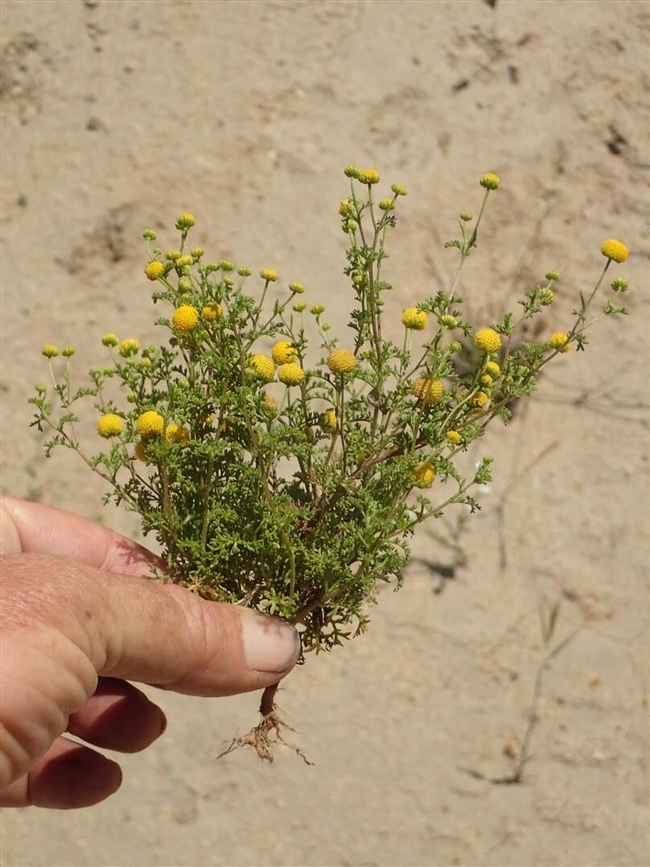
- Author: Ben Faber
Air Blast Sprayer Calibration
June 9, 3-4 PM
During this one hour live webinar, UCCE Farm Advisors Lynn Wunderlich and Franz Niederholzer will explain the importance of proper calibration and go through the steps of properly calibrating an air blast sprayer. This information is critical for PCAs, applicators, and growers of trees and vines so that pesticides are applied to the target crop at the proper application rate with good coverage and minimal drift.
One DPR CE unit (other) and one CCA CE unit (IPM) are pending.
Nozzle components from an air-blast sprayer being examined during a training class.
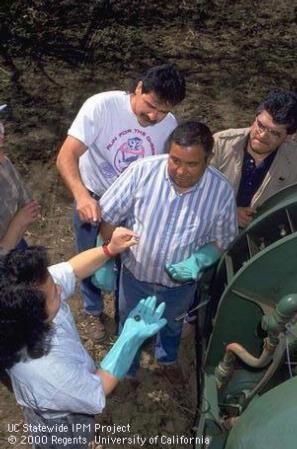
- Author: Ben Faber
Current status of
Laurel Wilt: A Disease of Avocado
-
Please find enclosed links to a recent on-line meeting of researchers from forestry and avocado production system perspectives on current laurel wilt research. The goal of the meeting was to briefly share information on current basic and applied research and ideas for controlling or mitigating the laurel wilt pathogen and the ambrosia beetle vectors. Below is the agenda.
https://ufl.zoom.us/rec/share/6tdrHq3spkxLRKuS2VOFGaEzRaS7X6a80SUfrqYJnkuVYiHCDKUa5wtKYTp5ucdn
https://ufl.zoom.us/rec/share/6tdrHq3spkxLRKuS2VOFGaEzRaS7X6a80SUfrqYJnkuVYiHCDKUa5wtKYTp5ucdn
Laurel wilt is a notorious example of the destructive capacity of beetle-borne fungi. Even more importantly, there is a vibrant community of researchers studying it! At this meeting we will host scientists and students that are actively solving the mysteries of this epidemic. We will hear about many topics, from glowing transgenic pathogen strains to field detection with sniffer dogs.
We hope that the laurel wilt community will also benefit from what our BBM Network has to offer. Exchanging results and experiences is important for the PIs, but perhaps even more for the students – designing and executing a laurel wilt related-project takes a long time, so it might be beneficial to get feedback earlier than at the publication stage. We see repeated mistakes that could be prevented, and old questions that would have been answered, if we talked more as a community. And how about people studying different ambrosia symbioses, beetles or pathogens? There is a lot of overlap but little information exchange with those outside of our field.
Participants
INTRODUCTION AND WELCOME
- 9:00 Jiri Hulcr: Short introduction to the Bark Beetle Mycobiome group (5 minutes)
MOLECULAR BIOLOGY
- Josh Konkol: GFP strain, colonization of the host plant by R. lauricola
- Jeff Rollins: Studying R. lauricola pathogenesis through comparative genomics and transcriptomics
- Qiang Wang: CRISPR-homologous recombination methods and deletion of genes from R. lauricola
- Ross A. Joseph: Swap of multiple GFP-labeled strains inside the vector
BIOLOGY
- Octavio Menocal Sandoval: Breeding Xyleborus, behavior of mating and symbiont swap
- Daniel Carrillo: Laurel wilt vectors in avocado
- Kirsten Stelinski: TBD
ECOLOGY,
- Denita Hadziabdic: Laurel wilt advancing North
- Robin Choudhury: LW dispatch from the Texas front
- Andrés Lira Noriega: Modelling for risk assessment of laurel wilt in Mexico
- Jason Smith: Redbay heritable resistance and rebounding populations
DETECTION
- Caterina Villari: Detection of laurel wilt pathogen in the field with LAMP
- DeEtta (Dee) Mills: Detector dogs
- Pedro Parra Giraldo: Culture-independent Laurel Wilt diagnosis in avocado groves
MANAGEMENT
- Romina Gazis: Testing “Out-Of-The-Box” Ideas to Control Laurel Wilt of Avocado
- José Luis Olivares-Romero: Synthesis of novel insecticides for the management of ambrosia beetles
- Jonathan Crane: Laurel wilt status in avocado groves and grower-initiated control
- Xavier Martini and Derrick Connover: Push-pull system to protect redbay and avocado against Laurel Wilt
